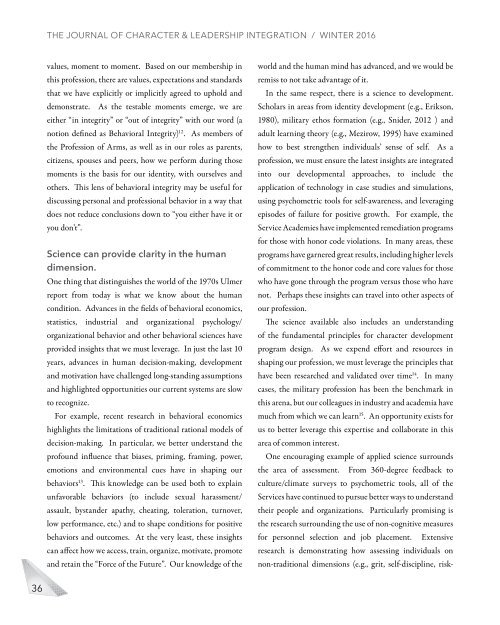PROFESSION OF ARMS
Yi5mwL
Yi5mwL
You also want an ePaper? Increase the reach of your titles
YUMPU automatically turns print PDFs into web optimized ePapers that Google loves.
THE JOURNAL <strong>OF</strong> CHARACTER & LEADERSHIP INTEGRATION / WINTER 2016<br />
values, moment to moment. Based on our membership in<br />
this profession, there are values, expectations and standards<br />
that we have explicitly or implicitly agreed to uphold and<br />
demonstrate. As the testable moments emerge, we are<br />
either “in integrity” or “out of integrity” with our word (a<br />
notion defined as Behavioral Integrity) 12 . As members of<br />
the Profession of Arms, as well as in our roles as parents,<br />
citizens, spouses and peers, how we perform during those<br />
moments is the basis for our identity, with ourselves and<br />
others. This lens of behavioral integrity may be useful for<br />
discussing personal and professional behavior in a way that<br />
does not reduce conclusions down to “you either have it or<br />
you don’t”.<br />
Science can provide clarity in the human<br />
dimension.<br />
One thing that distinguishes the world of the 1970s Ulmer<br />
report from today is what we know about the human<br />
condition. Advances in the fields of behavioral economics,<br />
statistics, industrial and organizational psychology/<br />
organizational behavior and other behavioral sciences have<br />
provided insights that we must leverage. In just the last 10<br />
years, advances in human decision-making, development<br />
and motivation have challenged long-standing assumptions<br />
and highlighted opportunities our current systems are slow<br />
to recognize.<br />
For example, recent research in behavioral economics<br />
highlights the limitations of traditional rational models of<br />
decision-making. In particular, we better understand the<br />
profound influence that biases, priming, framing, power,<br />
emotions and environmental cues have in shaping our<br />
behaviors 13 . This knowledge can be used both to explain<br />
unfavorable behaviors (to include sexual harassment/<br />
assault, bystander apathy, cheating, toleration, turnover,<br />
low performance, etc.) and to shape conditions for positive<br />
behaviors and outcomes. At the very least, these insights<br />
can affect how we access, train, organize, motivate, promote<br />
and retain the “Force of the Future”. Our knowledge of the<br />
world and the human mind has advanced, and we would be<br />
remiss to not take advantage of it.<br />
In the same respect, there is a science to development.<br />
Scholars in areas from identity development (e.g., Erikson,<br />
1980), military ethos formation (e.g., Snider, 2012 ) and<br />
adult learning theory (e.g., Mezirow, 1995) have examined<br />
how to best strengthen individuals’ sense of self. As a<br />
profession, we must ensure the latest insights are integrated<br />
into our developmental approaches, to include the<br />
application of technology in case studies and simulations,<br />
using psychometric tools for self-awareness, and leveraging<br />
episodes of failure for positive growth. For example, the<br />
Service Academies have implemented remediation programs<br />
for those with honor code violations. In many areas, these<br />
programs have garnered great results, including higher levels<br />
of commitment to the honor code and core values for those<br />
who have gone through the program versus those who have<br />
not. Perhaps these insights can travel into other aspects of<br />
our profession.<br />
The science available also includes an understanding<br />
of the fundamental principles for character development<br />
program design. As we expend effort and resources in<br />
shaping our profession, we must leverage the principles that<br />
have been researched and validated over time 14 . In many<br />
cases, the military profession has been the benchmark in<br />
this arena, but our colleagues in industry and academia have<br />
much from which we can learn 15 . An opportunity exists for<br />
us to better leverage this expertise and collaborate in this<br />
area of common interest.<br />
One encouraging example of applied science surrounds<br />
the area of assessment. From 360-degree feedback to<br />
culture/climate surveys to psychometric tools, all of the<br />
Services have continued to pursue better ways to understand<br />
their people and organizations. Particularly promising is<br />
the research surrounding the use of non-cognitive measures<br />
for personnel selection and job placement. Extensive<br />
research is demonstrating how assessing individuals on<br />
non-traditional dimensions (e.g., grit, self-discipline, risk-<br />
36


